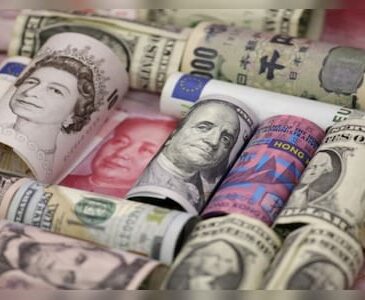Investors trim bearish bets on most Asian currencies as Sino-U.S. trade tensions ease: Reuters poll

By Aditya Soni
(Reuters) – Investors have trimmed their short positions on Asian currencies over the last two weeks, a Reuters poll showed, as a weaker dollar, coupled with optimism over Sino-U.S. trade tensions and tightening monetary policy in the region improved risk appetite.
Bearish bets on the Chinese yuan were sharply reduced in the wake of the latest round of Sino-U.S. trade talks, the survey showed. Short positions fell to their lowest since late-May, when bets on the Chinese currency were slightly bullish.
“At least they are talking, that’s the bottom line and the fact that they’re talking itself has been taken as a positive,” said Sim Moh Siong, FX Strategist at Bank of Singapore.
The poll of 10 market participants also showed that investors trimmed their short positions on four other Asian currencies.
The broad lift in sentiment towards emerging Asian currencies came on rising optimism over ongoing U.S.-China trade talks, and after U.S. President Donald Trump’s critique of Federal Reserve’s interest-rate hike cycle led to a weakness in the dollar.
Risk appetite was also bolstered by policy responses from several Asian central banks.
Earlier this month, Philippine central bank made its biggest rate hike in 10 years – raising key interest rates by 50 basis points – and left the door open for further policy tightening. The poll showed short positions in the Philippine peso narrowed to levels last seen in mid-May.
Short positions on the Thai baht also hit their lowest since May-end, bolstered by hawkish comments from the central bank governor.
This week, Bank of Thailand Governor Veerathai Santiprabhob said the country cannot buck the global policy tightening trend but noted any interest rate hike would be gradual.
“I think the response of the regional central banks has been in the right direction,” said Bank of Singapore’s Sim.
“Whether the currencies can stabilise ultimately depends on the outcome of the China-U.S. trade tensions but at least on the part of the individual countries within the region, policy makers are stepping up to the plate.”
Export-driven South Korean won and Taiwan dollar saw bearish positions fall to their lowest since May and mid-July, respectively.
However, investors raised short positions on the Indonesian rupiah, Indian rupee and Singapore dollar.
Indonesia’s central bank raised interest rates for the fourth time since mid-May last week, in an effort to defend a beleaguered currency.
The rupiah has lost nearly 7 percent since this beginning of the year, making it second-worst performing Asian currency so far.
The Indonesian currency has been hit with a combination of a rising trade deficit, worsening macro trade conditions and lower growth outlook.
Meanwhile, short positions on the Singapore dollar hit their highest since late June.
Singapore’s economy grew slower than initial estimates in the April-June period on a quarter-on-quarter basis, as the government flagged a likely moderation in growth in the second half.
Short positions on the Indian rupee, the worst performing Asian currency so far this year, also rose.
The rupee hit an all time low on 69.62 per dollar on August 13. India faces significant headwinds as rising oil prices could spur its trade deficit and prop up inflation, which remains a central concern.
Last week, India’s Statistics Ministry said that retail inflation numbers eased in July but remained over central bank’s target medium-term target of 4 percent.
The Asian currency positioning poll is focused on what analysts and fund managers believe are the current market positions in nine Asian emerging market currencies: the Chinese yuan, South Korean won, Singapore dollar, Indonesian rupiah, Taiwan dollar, Indian rupee, Philippine peso, Malaysian ringgit and the Thai baht.
The poll uses estimates of net long or short positions on a scale of minus 3 to plus 3.
A score of plus 3 indicates the market is significantly long U.S. dollars. The figures included positions held through non-deliverable forwards (NDFs).
The survey findings ASIAPOSN are provided below (positions in U.S. dollar versus each currency):
DDMM CNY KRW SGD IDR TWD INR MYR PHP THB
23/8 0.93 0.71 0.84 1.27 0.91 1.19 0.88 0.86 0.47
9/8 1.52 0.94 0.80 1.21 0.99 1 0.86 1.02 0.66
26/7 1.55 1.08 0.84 1.35 1.13 1.25 0.76 1.44 0.87
12/7 1.00 0.91 0.68 1.31 0.88 1.18 0.64 1.35 0.70
28/6 1.28 1.03 0.94 1.32 1.03 1.43 0.94 1.58 0.73
31/5 -0.15 -0.17 0.39 1.06 0.33 1.42 0.69 1.25 0.06
17/5 -0.28 -0.33 0.28 1.08 0.07 1.31 0.21 0.68 -0.14
3/5 -0.23 -0.38 -0.08 0.56 0.04 1.11 -0.24 0.47 -0.4
19/4 -0.52 -0.21 -0.44 0.14 -0.28 0.49 -0.19 0.74 -0.36
5/4 -0.65 -0.90 -0.50 0.10 -0.66 -0.05 -0.40 0.73 -0.60
22/3 -0.61 -0.48 -0.36 0.52 -0.59 0.41 -0.29 1.13 -0.72
8/3 -0.61 -0.64 -0.61 0.24 -0.54 0.19 -0.70 1.05 -0.99
(Reporting by Aditya Soni in Bengaluru; additional reporting by Ambar Warrick & Aaron Saldanha; Editing by Sam Holmes)


